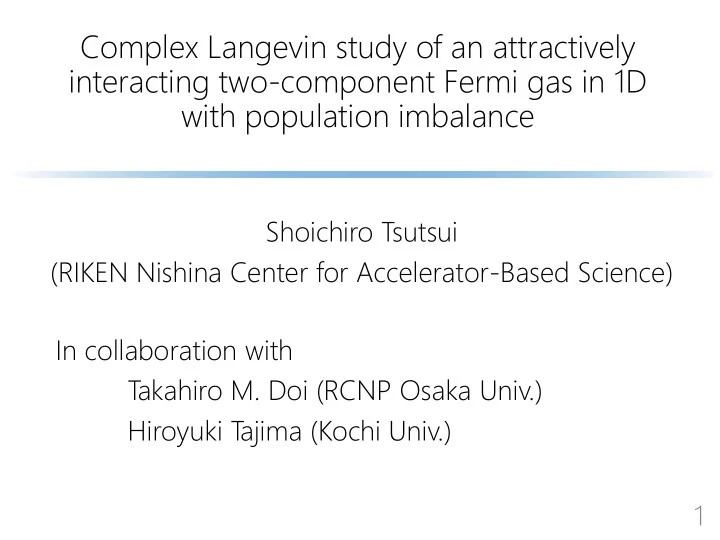

Complex Langevin study of an attractively interacting two-component Fermi gas in 1D with population imbalance Shoichiro Tsutsui (RIKEN Nishina Center for Accelerator-Based Science) In collaboration with T akahiro M. Doi (RCNP Osaka Univ.) Hiroyuki T ajima (Kochi Univ.) 1
My research interest : QCD QCD at fi finite ite de densi sity 2 J. Phys.: Conf. Ser. 706 022004
Fermi rmi gas PRL 124, 203402 (2020) 3
Common feature: sign problem 4
Common feature: sign problem What is the sign problem ? Sign problem in cold atom (and QCD) Complex Langevin (theory and application) 5
Sign problem: an intuitive picture Numerical evaluation of highly oscillatory integrals is difficult 6
Sign problem: precise statement Monte Carlo o evaluation of highly oscillatory integrals is difficult 7
Monte Carlo integration Positive semi-definite Random number is viewed as a probability density function if 8
Monte Carlo integration for complex P(x) Non positive semi-definite is not viewed as a probability density function if 9
Monte Carlo integration for complex P(x) 10
Monte Carlo integration for complex P(x) This procedure is known as reweighting. 11
Monte Carlo integration for complex P(x) Positive semi-definite Evaluate the numerator and denominator separately 12
Sign problem: more precise statement Statistical error Signal-to-noise ratio is expo pone nent ntially ially sm small 13
Sign problem in ultracold Fermi gas Grand partition function attractive contact interaction 14
Sign problem in ultracold Fermi gas Grand partition function Hubbard-Stratonovich transformation 15
Sign problem in ultracold Fermi gas Grand partition function Non positive semi-definite Reweighting Sign problem Except for 16
Sign problem in other systems Fermion determinant is non positive semi-definite when • Even species of fermions with imbalance ( ↑≠↓ ) • Odd species of fermions • Repulsive interaction Related topics: polaron, FFLO, High-T c superconductor, Effimov effect, bose- fermi mixture, … 17
Sign problem in QCD Fermion determinant is non positive semi-definite when • Chemical potential is nonzero Condition of positivity is different from that in non-rela. system 18
Complex Langevin Parisi, Phys. Lett. 131B (1983) 393, Klauder PRA 29 (1984) 2036 19
Complex Langevin Drift term White noise Parisi, Phys. Lett. 131B (1983) 393, Klauder PRA 29 (1984) 2036 20
Complex Langevin Reach equilibrium Parisi, Phys. Lett. 131B (1983) 393, Klauder PRA 29 (1984) 2036 21
Justification of complex Langevin I f or has “good” properties, Obtained by complex Langevin Original path integral Aarts, Seiler, Stamatescu, PRD 81 (2010) 054608 Aarts, James, Seiler, Stamatescu, EPJ C71 (2011) 1756 Nagata, Nishimura, Shimasaki, PRD 92 (2015) 011501, PTEP 2016 013B01 22
Practically useful criterion Distribution of the drift term should decay exponen nential tially ly. Expo ponentia nential l decay cay Power-law. decay Nagata, Nishimura, Shimasaki, PRD 92 (2015) 011501, PTEP 2016 013B01 23
Application Our setup: • Two-component Fermion • Attractive contact interaction • 1D Corresponding Hamiltonian: 24
Application Our setup: • Two-component Fermion • Attractive contact interaction • 1D • Lattice regularization 25
Application Our setup: • Two-component Fermion • Attractive contact interaction • 1D • Lattice regularization 26
Application Our setup: • Two-component Fermion • Attractive contact interaction • 1D • Lattice regularization Continuum limit: 27
Dimensionless parameters We set* * This is not the natural unit, where c=1 ! 28
What is expected ? Poralon (inpurity dressed by medium) Pseudogap https://physics.aps.org/articles/v9/86 FFLO-like state 29 Orso, PRL 98 (2007) 070402 T ajima, ST, Doi, arXiv:2005.12124
What is expected ? Poralon lon ← T oday’s topic Pseudogap https://physics.aps.org/articles/v9/86 FFLO-like state 30 Orso, PRL 98 (2007) 070402 T ajima, ST, Doi, arXiv:2005.12124
Complex Langevin works ! Exponential decay 31
Extracting the polaron energy 32
Dispersion relation of polaron Momentum in lattice unit Fitting function: 33
Dispersion relation of polaron : Polaron energy Momentum in lattice unit Fitting function: 34
Polaron energy T emperature : scattering length : determined by 35
Exact result at T=0 limit obtained by thermodynamic Bethe ansatz J. B. McGuire, J. Math. Phys. 7, 123 (1966). 36
Exact result at T=0 limit obtained by TBA J. B. McGuire, J. Math. Phys. 7, 123 (1966). Continuum limit 37
Exact result at T=0 limit obtained by TBA J. B. McGuire, J. Math. Phys. 7, 123 (1966). Continuum limit T=0 limit 38
Exact result at T=0 limit obtained by TBA J. B. McGuire, J. Math. Phys. 7, 123 (1966). Continuum limit T=0 limit Complex Langevin agrees with TBA 39
Summary What is the sign problem ? • Exponentially small signal-to-noise ratio in Monte Carlo simulations Sign problem in cold atom • Non positive definite fermion determinant causes the sign problem. Complex Langevin (theory and application) • In our setup (1D, attractive, βh≠ 0), complex Langevin is reliable. • We obtain polaron energy at T ≠ 0 • Consistent with TBA 40
Appendix 41
42
Recommend
More recommend